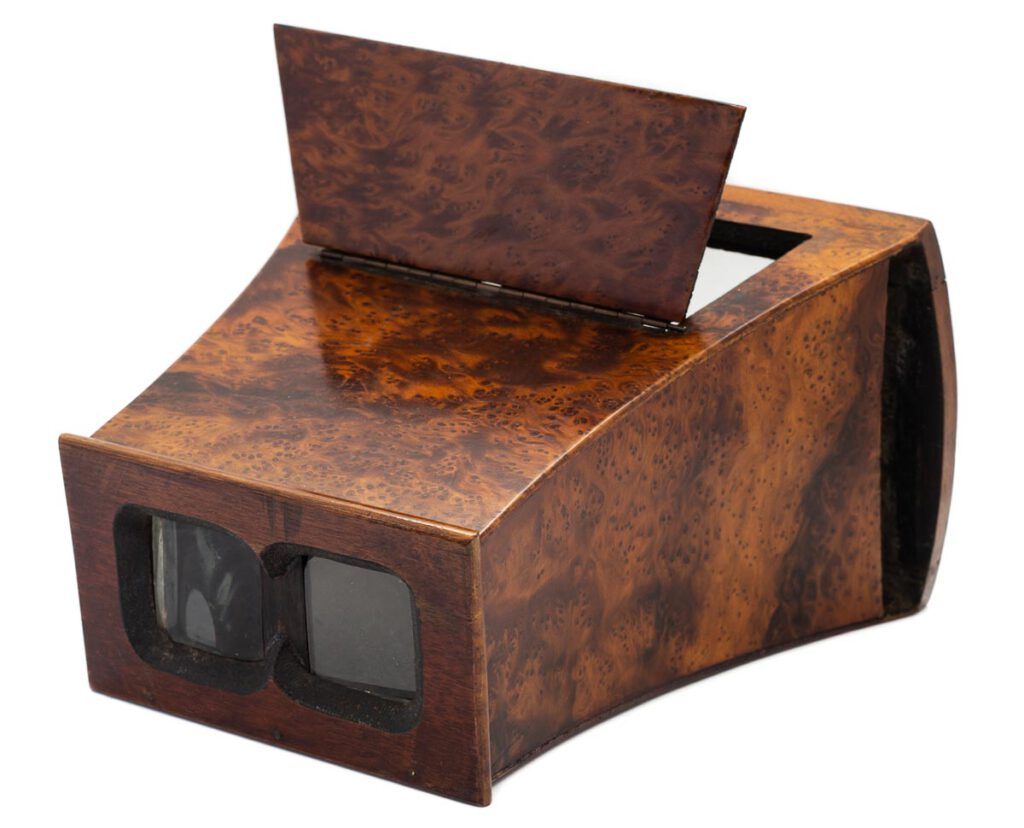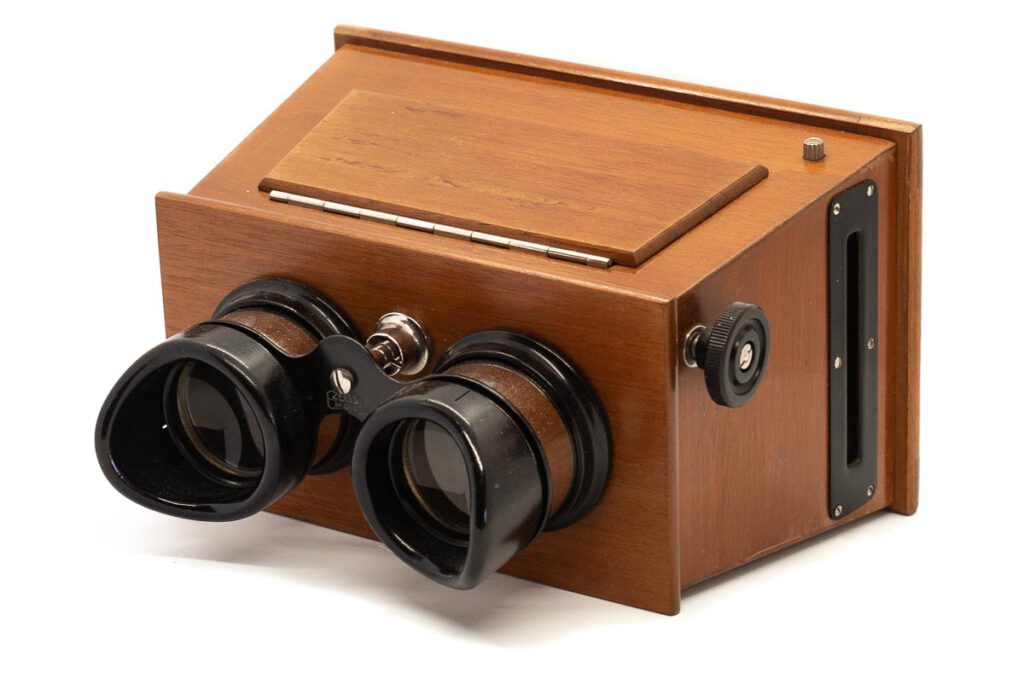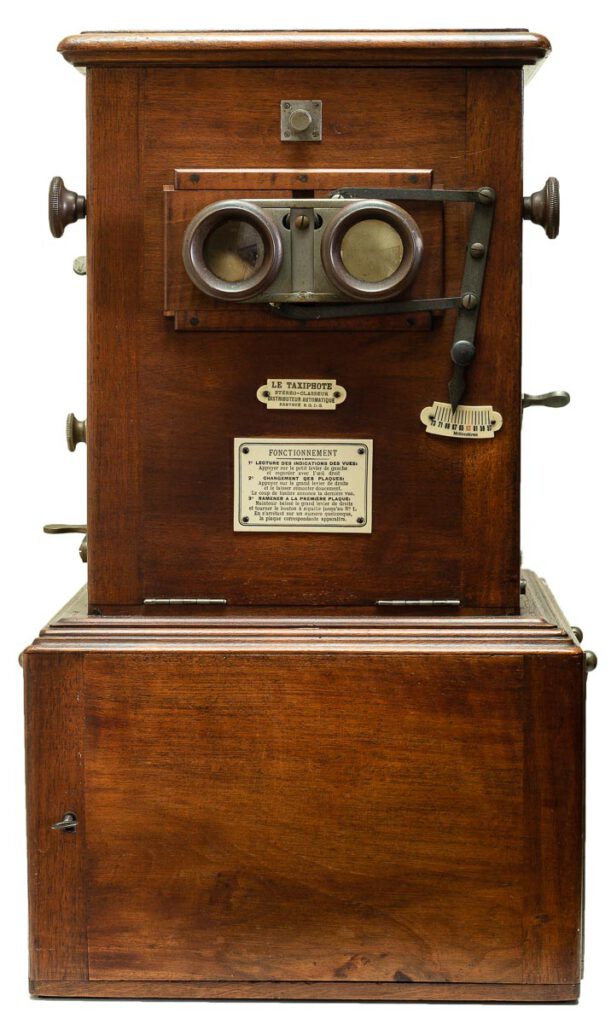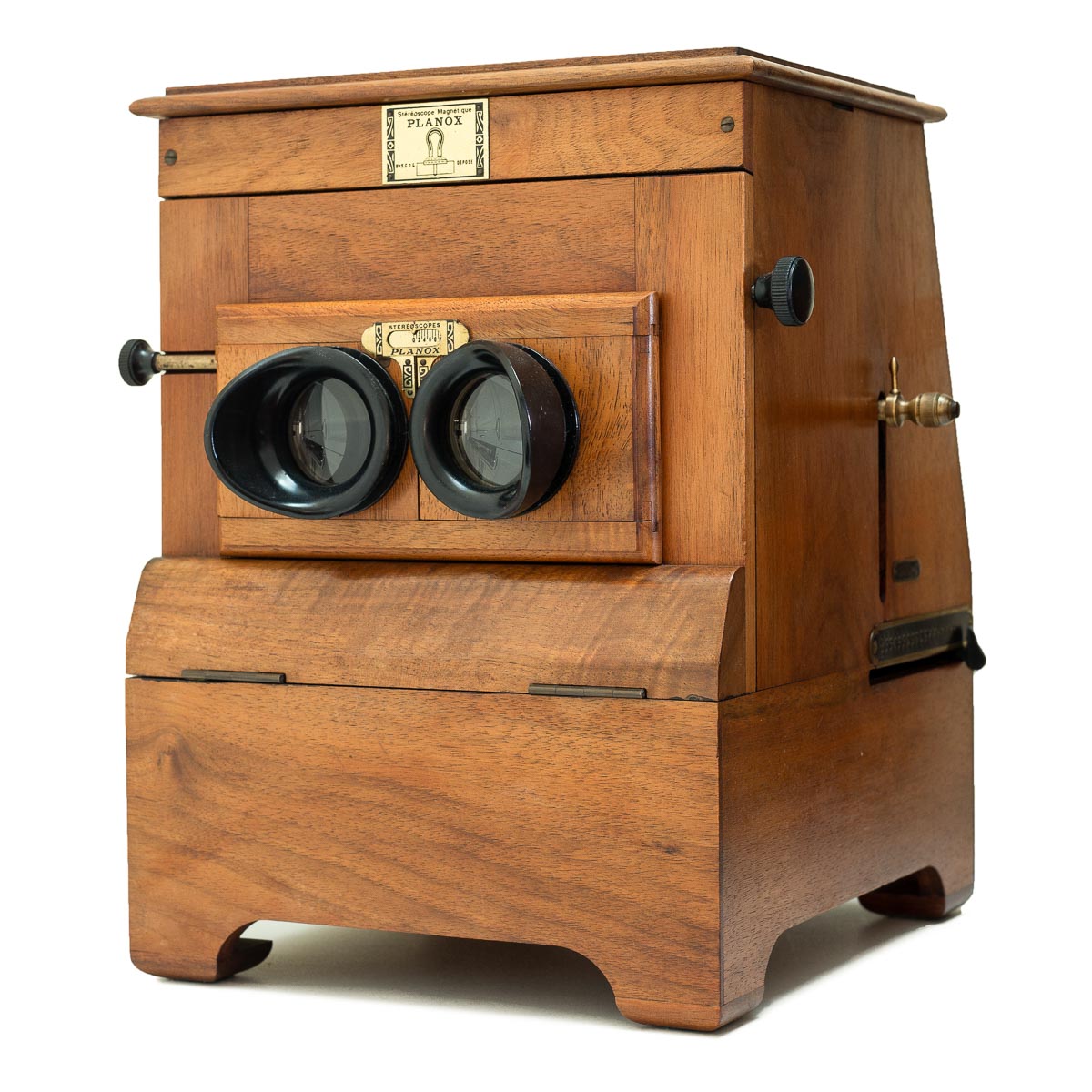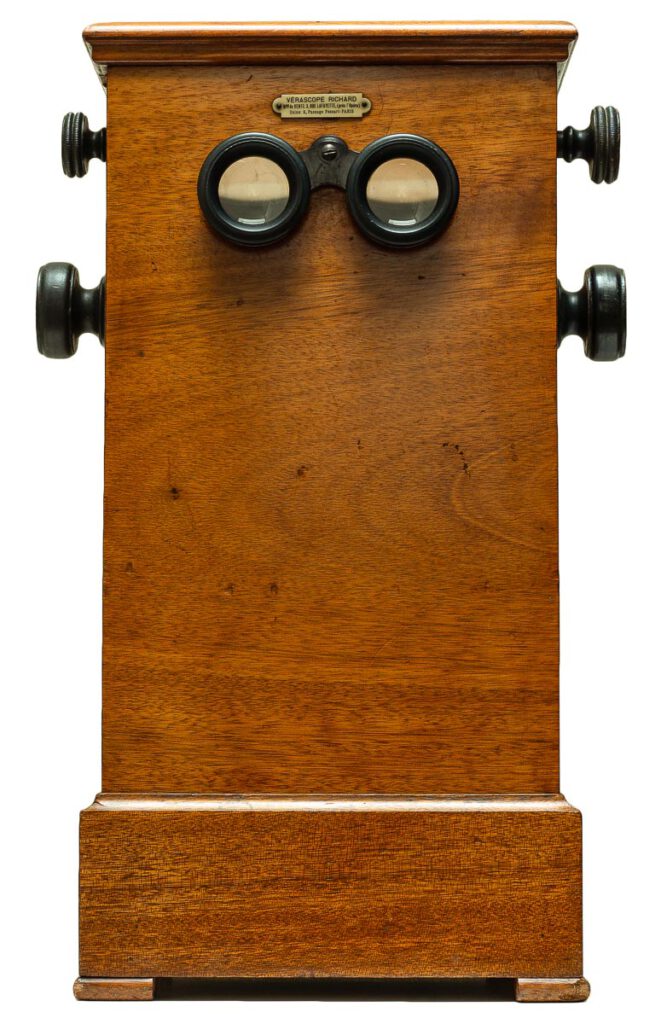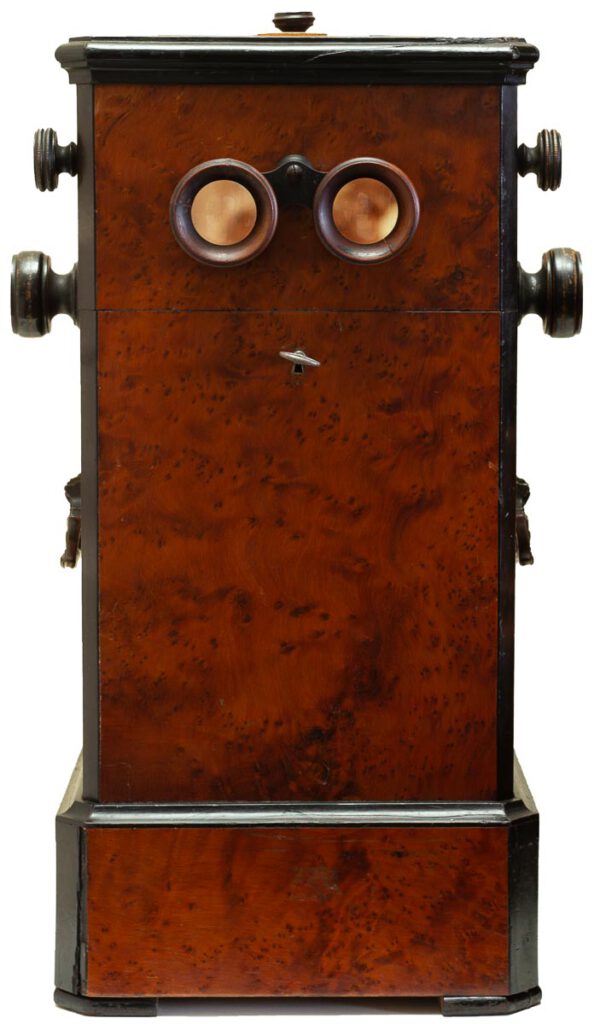Collecting Stereoscopes
written for the stereosite by André Ruiter, The Netherlands
In my previous post I shared some tips about collecting stereoviews on online auction sites. This time I will talk about collecting antique stereoscopes for glass stereoviews from the period 1850 to 1930. Some tips from my previous post can also be applied to stereoscopes, so I recommend to read this post first. However, collecting stereoscopes comes with some additional challenges that I will address now.
Stereoscope types
There are two types of stereoscopes: handheld stereoscopes and table stereoscopes. Within these main groups there are many variations and I will not cover all of them. The handheld stereoscopes are generally simple devices to view stereoviews one by one. A table stereoscope offers more functionality and this group also includes the sophisticated multi-view devices. In this post I will focus on a number of viewers that are readily available.
Define your goal
First, you have to determine your goal before acquiring a stereoscope. Do you want to use it for viewing your collection or is it primarily intended as a decorative item in your showcase? The first viewers from the period 1850 – 1870 are beautiful, but they don’t offer the best optical quality. You’re better off with a later model from around 1910 – 1930 to view your collection. I have a beautiful early Brewster style handheld stereoscope from around 1860. It looks nice in my cabinet, but to enjoy my glass slides I prefer the Zeiss Ikon viewers from the late 1920s.
Different formats
The most common glass stereoview formats are 45 x 107mm, 6 x 13cm and 8.5 x 17cm. Most stereoscopes only support one format. I’ve noticed that the supported format is not always mentioned by the seller or an incorrect format is listed. Keep this in mind and contact the seller if in doubt.
Handheld stereoscopes
A wooden closed box viewer is a good start to view your collection. Finding such a viewer is quite easy because they’re widely available. Not much can go wrong with these viewers and if the seller has made a series of good photos, the choice can be made quickly. Make sure the lenses are clear and free of fungus and the eyepiece holders are not rusty. Scratches on the woodwork are not your biggest problem when your intention is to use it for viewing your collection.
Table stereoscopes – slide tray
The showpiece in your collection should be (in my humble opinion) a beautiful slide tray multiviewer. These devices are easy to use, decorative and provide a good viewing experience. The disadvantage is that they are expensive and there is a greater risk that the advance mechanism is not in optimal condition. They often use gears and springs to position the stereoviews and to transport the slide tray over a rail. These are precision instruments and a small deviation can cause the glass slides to jam.
The most ideal situation is to test the device before buying. If this is not possible, the advice is to contact the seller and ask for detailed information. Keep in mind that not every buyer is aware of what they are selling. The stereoscope may be inherited and the seller may have little knowledge of the device and how it works. This will become clear from the answers you’ll get. If the seller has no clue, just move on or take the risk. If the seller has some knowledge about the the viewer, ask if it can show all images one by one, without getting jammed. If this is the case, you’re probably good to go.
After receiving your stereoscope, I recommend you test it with some uninteresting glass stereoviews from your collection. You don’t want to destroy your precious stereoviews because of a jamming viewer.
About auction houses
Sometimes stereoscopes are offered by an auction house. They auction large numbers of objects at the same time and are not necessarily specialized in stereoscopy. You can ask if the device is in good condition, but often they simply do not know and don’t have the skills or time to perform a test.
Slide tray included please…
If you want to use your desired stereoscope with slide trays, it’s good to ask if at least one tray is included. When buying a Taxiphote or Métascope, this is less important because these slide trays are reasonably available. Finding a slide tray for a Polyphote or Multiphote can be a big challenge.
Table stereoscopes – chain type
An alternative to the slide tray device is the chain type revolving stereoscope. These are the most simple multi-view devices and they often support both glass stereoviews and paper stereocards. They pop up on auction sites regularly for reasonable prices. Because of their simple mechanism they are often in good working order, but the viewing experience of these devices is generally not very good and replacing stereoviews is cumbersome. I have some chain type viewers as I like their appearance, but I don’t use them often for viewing my collection.
How is it presented?
Pay attention to how the stereoscope is presented on the online auction site. Some sellers ask $1000 for a table viewer, but all you can see are some blurry images and a description “good condition”. I cannot recommend these sellers. I prefer sellers who take the trouble to show a series of good photos with an extensive description. It’s no guarantee for a satisfying acquisition, but at least it’s a good start.
Don’t hesitate to ask for extra images when in doubt. If the price is high, you should expect a seller to help you. It’s also a good way to get a feel for the seller. How quickly does the seller respond? Do you get comprehensive answers? It can all help you to purchase with confidence.
What’s a good price?
In my experience, sellers generally ask too much for a stereoscope or have a high starting bid. This applies to both handheld stereoscopes and the table models. Handheld stereoscopes are easily offered between $200 and $500, but a price between $100 and $250 for a device in good condition is more realistic. If it’s in mint condition or rare you can pay more. For a table stereoscope with slide trays in good condition you should think between $500 and $1,000. I bought my Taxiphote for $800, which is a good price as it’s in excellent condition. However, this same Taxiphote type is easily offered for $1,500. My price estimates are based on the European market. I’ve understood that the prices of stereoscopes in the United States are much higher.
André Ruiter (Putten, The Netherlands)
I’m a Dutch photographer who specializes in conceptual black & white photography. My photo projects are based on historic themes.
While working on a project about the First World War battlefield of Verdun in France, I discovered French glass stereoviews. This resulted in my great interest in stereo photography and I am now a passionate collector of French and German stereoscopy antiques from 1850 to 1930.
On my website I share my black & white photography and blogs about stereoscopy history and my collection.
Website: www.andreruiter.nl
Instagram-profile: andreruiter
Facebook-profile: andreruiterphotography

